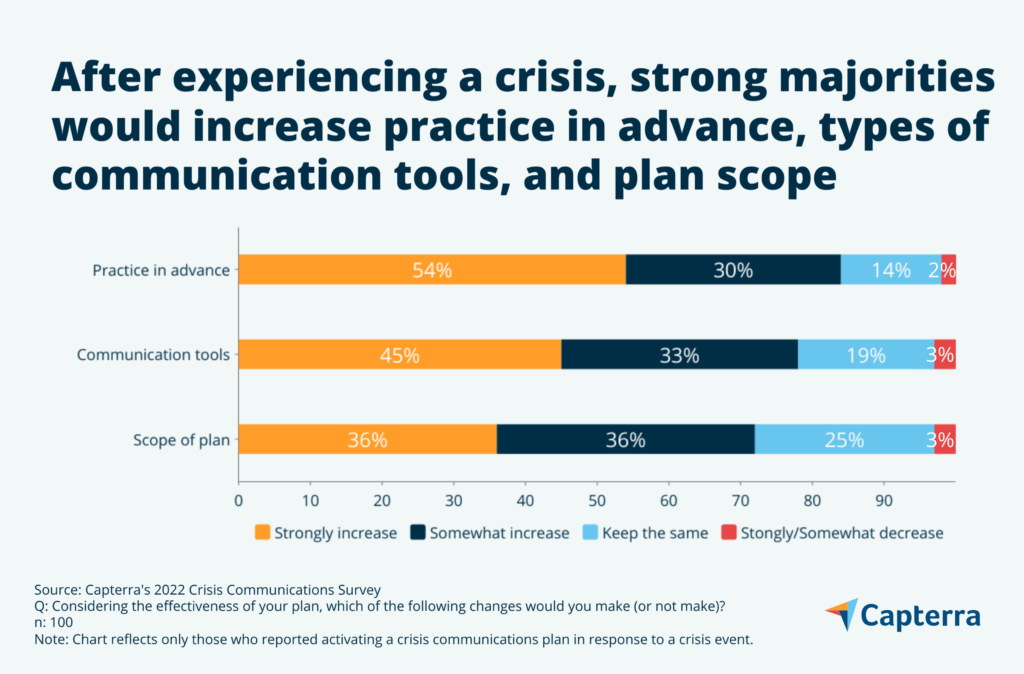In a world where organizational volatility is a feature and not a bug, mastering effective crisis communication is a must.
This article provides insights into the essential elements of successful crisis communication, encompassing the need for transparency, consistency, empathy, and adaptability. The goal here is to elevate your understanding of crisis comms and its pivotal role in fortifying organizational resilience for sustained long-term success in the face of adversity.
What is crisis communication?
Crisis communication refers to the strategic process of conveying information during an emergency or challenging situation to manage and mitigate its impact. This communication involves addressing the public, stakeholders, and the media to provide accurate, timely, and transparent information. The objective is to maintain or rebuild trust, minimize potential harm, and guide individuals through the crisis while presenting a cohesive and responsible organizational image. Effective crisis communication involves clear messaging, empathy, and a well-coordinated response to ensure that key information is disseminated to all relevant parties.
Why is crisis communication important?
The year 2023 alone saw a troubling range of unforeseen crises erupting around the globe. In the world of business, they’ve included holiday travel chaos at Southwest Airlines, a Taylor Swift controversy at Ticketmaster, the implosion of Silicon Valley Bank, and leadership chaos at OpenAI.
What these events have in common, aside from the confusion and turmoil they wrought, was that all of them could have been better managed — and perhaps even avoided — had they been met with a well planned, more visionary crisis communication response.
Crisis communication is crucial for organizations. Its goal is to protect and defend an organization, its stakeholders, and its reputation in the face of any unforeseen event that threatens their reputation, operations, and relationships.
Transparent and timely communication during a crisis helps build trust, reduces uncertainty, and allows organizations to take control of the narrative.
By addressing concerns head-on, demonstrating accountability, and providing accurate information, organizations can navigate crises more effectively, minimizing damage and facilitating a quicker recovery.
Some crisis communication examples:
Product Recalls
A food company discovers contamination in one of its popular products, leading to a nationwide recall. The proper response: The company issues public statements, communicates with regulatory agencies, and outlines steps taken to address the issue.
Natural Disasters
A hotel in a coastal area faces a hurricane, resulting in the evacuation of guests and potential damage to the property. The proper response: The hotel communicates evacuation plans, provides updates on the status of the facility, and assures guests of their safety.
Data Breaches
A technology company experiences a data breach, compromising customer information. The proper response: The company communicates promptly about the breach, outlines steps taken to secure data, and provides guidance on what affected customers should do.
Financial Issues
A publicly traded company faces financial challenges, leading to a significant drop in stock value. The proper response: The company's leadership communicates with shareholders, analysts, and the media to explain the situation, outline recovery plans, and restore investor confidence.
Workplace Incidents
A manufacturing company experiences a workplace accident resulting in injuries. The proper response: The company communicates with employees, their families, regulatory bodies, and the public to provide information on the incident, steps taken to address safety concerns, and support for affected individuals.
Leadership Controversies
A high-profile executive of a company is involved in a controversy. The proper response: The organization communicates with employees, customers, and the public to address the situation, express commitment to ethical or organizational standards, and outline any actions taken regarding the executive.
Social Media Backlash
A company's social media campaign is perceived as offensive, leading to widespread criticism and a potential boycott. The proper response: The organization issues public apologies, clarifies its intentions, and revises its communication strategy to address concerns.
Legal Issues
A pharmaceutical company faces lawsuits related to the safety of one of its drugs. The proper response: The company communicates with the public, healthcare professionals, and regulatory agencies to provide information on the drug's safety profile, ongoing investigations, and any measures taken to ensure patient safety.
These examples highlight the diverse nature of crises and the importance of tailored communication strategies to address each unique situation. In each case, effective crisis communication involves transparency, empathy, and a commitment to resolving the issues at hand.
What makes a good crisis communication plan?
Capterra’s Crisis Communications Survey, conducted in January 2023, found that only 49% of surveyed US companies have a formal crisis communication plan. Another 28% have an informal, undocumented crisis communications plan, and almost a quarter (23%) have none at all — or aren't confident that they do.
That same survey revealed that 98% of business leaders who have needed to activate a crisis communication plan report it being effective — with 77% saying it was very effective. Nevertheless, 72% said they’d further increase the scope of the plan, with more than three out of four (78%) saying they’d increase the tools they use for communication.

McKinsey reports that In the 2020–21 economic recovery, resilient companies, those prepared to mitigate crises, generated a total shareholder return that was 50% higher than their less resilient peers.
A simple yet effective crisis communication plan is clearly a necessity, and will typically consist of certain key elements. These can be adapted to various organizations and crisis situations.
Here's a basic outline that can serve as a starting point:
Preparedness
- Identify Potential Risks: Conduct a risk assessment to identify and rectify potential crises that could impact your organization.
- Establish a Crisis Team: Form a cross-functional crisis communication team with designated roles and responsibilities.
- Develop Key Messages: Prepare core messages that can be adapted to different crisis scenarios, emphasizing transparency, responsibility, and a commitment to resolution.
Communication Protocols
- Define Communication Channels: Identify primary communication channels, including press releases, social media, website, and direct communication with stakeholders.
- Designate Spokespersons: Clearly identify and train spokespersons who will communicate with the media and other stakeholders.
Monitoring and Detection
- Implement Monitoring Systems: Set up systems to monitor news, social media, and other sources for early detection of potential crises.
- Establish Reporting Procedures: Define how and when team members should report a potential crisis to the crisis communication team.
Response
- Activate Crisis Team: When a crisis occurs, immediately activate the crisis communication team.
- Assess the Situation: Gather accurate information about the crisis to inform communication strategies.
- Initial Public Statement: Issue an initial public statement acknowledging the situation, expressing concern, and outlining the organization's commitment to addressing the crisis.
Transparency and Updates
- Communicate Transparently: Be open and honest about the situation, acknowledging any mistakes and providing accurate information.
- Regular Updates: Provide regular updates to stakeholders through appropriate channels to keep them informed of developments and actions being taken.
Stakeholder Engagement
- Employee Communication: Communicate with employees first to ensure they are informed and feel supported.
- Customer Communication: Address the concerns of customers and provide information on how the organization is addressing the situation.
- Media Relations: Work closely with the media, providing timely and accurate information to manage the narrative.
Adaptability
- Monitor and Adjust: Continuously monitor the situation, feedback, and stakeholder reactions. Adjust communication strategies as needed to address evolving circumstances.
Aftermath and Recovery
- Post-Crisis Evaluation: Conduct a post-crisis evaluation to assess the effectiveness of the communication plan and identify areas for improvement.
- Rebuild Trust: Develop strategies to rebuild trust and reputation, including ongoing communication about corrective actions and preventive measures.
Remember, the effectiveness of your crisis communication plan will depend on its relevance to your specific organization and crisis. Regular training, simulations, and updates to the plan are essential to ensure ongoing preparedness for unforeseen events.
The dos and don'ts of an effective crisis communication strategy
Do:
Be Proactive: Anticipate potential crises and develop a communication plan in advance. Identify key stakeholders and establish communication channels.
Be Transparent: Provide clear, honest, and timely information to the public and stakeholders. Acknowledge the severity of the situation and its potential impact.
Designate a Spokesperson: Appoint a credible and trained spokesperson to represent your organization. Ensure they have accurate and up-to-date information.
Be Empathetic and Compassionate: Express empathy and understanding for those affected by the crisis. Show genuine concern and a commitment to resolving the situation.
Provide Consistent Messaging: Maintain a consistent message across all communication channels. Avoid contradictory statements that may confuse or escalate the crisis.
Use Multiple Communication Channels: Utilize various communication platforms, such as press releases, social media, and official statements, to reach different audiences. Adapt the message to suit the specific channel while maintaining consistency.
Address Concerns and Questions: Anticipate and address potential concerns or questions from the public. Establish mechanisms for receiving and responding to feedback.
Collaborate with Authorities: Work closely with relevant authorities and agencies. Follow any legal or regulatory requirements for communication during a crisis.
Update Regularly: Keep stakeholders informed with regular updates as new information becomes available. Clearly communicate any changes in the situation or the organization's response.
Learn and Improve: Conduct a thorough review of your crisis communication strategy after the event. Identify areas for improvement and update the crisis communication plan accordingly.
Don't:
Deny or Minimize: Avoid denying or minimizing the severity of the crisis. Fully acknowledge the situation and its potential impact.
Speculate or Guess: Refrain from speculating or providing unverified information. Stick to the facts and provide accurate details.
Blame Others Prematurely: Do not assign blame without a thorough understanding of the facts. Focus on resolving the crisis rather than pointing fingers.
Ignore Social Media: Do not neglect social media as a communication channel. Monitor and engage with appropriate social media platforms to address concerns and correct misinformation.
Overpromise: Avoid making promises that cannot be kept. Be realistic about what can be achieved and communicate accordingly.
Isolate Communication: Do not isolate communication to a single channel or platform. Use a variety of communication channels to reach different audiences.
Neglect Internal Communication: Ensure that internal communication is as thoughtful and transparent as external communication. Keep employees informed to prevent internal confusion.
Wait Too Long to Respond: Avoid delaying your initial response. Respond promptly to address the crisis and demonstrate that it is being actively managed.
Assume the Crisis Will Resolve Itself: Do not assume that the crisis will resolve itself without active management. Take proactive steps to address the situation and communicate the organization's response.
Neglect Follow-Up: Do not neglect follow-up communication after the crisis subsides. Keep stakeholders informed about ongoing efforts, resolutions, and any long-term impacts.
Our 7 step plan for communicating in a crisis
- Preparedness: Develop your crisis communication plan in advance, which includes identifying potential risks, establishing communication protocols, and training key personnel to respond effectively.
- Response: React promptly and strategically when a crisis occurs. This involves providing accurate and timely information to stakeholders, addressing concerns, and demonstrating that the organization is taking appropriate actions to manage the situation.
- Transparency: Be open and honest about the situation. Transparency builds trust and credibility, whereas attempts to conceal or downplay the severity of a crisis can lead to further damage.
- Consistency: Ensure that messaging is consistent across all communication channels to avoid confusion and conflicting information.
- Empathy: Demonstrate empathy and understanding towards those affected by the crisis, including employees, customers, and the community. This can involve acknowledging the impact of the crisis and expressing concern for the well-being of the individuals involved.
- Adaptability: Adjust communication strategies as the crisis evolves and new information becomes available. Flexibility is essential to address changing circumstances effectively.
- Recovery: Communicate the steps the organization is taking to recover from the crisis and prevent similar incidents in the future. This can involve long-term reputation management efforts.




